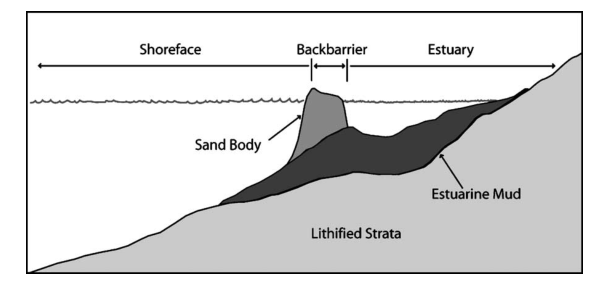A new morphological-behaviour model is used to simulate evolution of coastal morphology associated with cross-shore translations of the shoreface, barrier, and estuary. The model encapsulates qualitative principles drawn from established geological concepts that are parameterized to provide quantitative predictions of morphological change on geological time scales (order 103 years), as well as shorter time scales applicable for long-term coastal management (order 101 to 102 years). Changes in sea level, and sediment volume within the shoreface, barrier, and estuary, drive the model behaviour. Further parameters, defining substrate erodibility, sediment composition, and time-dependent shoreface response, constrain the evolution of the shoreface towards an equilibrium profile. Results from numerical experiments are presented for the low�gradient autochthonous setting of North Carolina and the steep allochthonous setting of the Washington shelf. Simulations in the Currituck region of North Carolina examined the influence of sediment supply, substrate composition, and substrate erodibility on barrier transgression. Results demonstrate that the presence of a lithified substrate reduces the rate of barrier transgression compared to scenarios where an erodible, sand-rich substrate exists. Simulations of the Washington coast, 20 km north of the Columbia River, confirmed that the model can reproduce complex stratigraphy involving regressive and transgressive phases of coastal evolution. Results suggest that the first major addition of sediment to the shelf occurred around 12 900 years ago and resulted from the rapid addition of sediment volume from the Columbia River attributed to the Missoula floods. This was followed by a period where little or no sediment was added (12 400–9100 BP) and a third period when most sediment was added to the shelf (9100 BP to present) from the Columbia River. Comparing results from each setting demonstrates an indirect control that substrate slope has on shoreface transgression rates. Shoreface transgression is shown to be sensitive to the rate of estuarine sedimentation, with the sensitivity increasing as substrate slope decreases.

GEOMBEST’s equilibrium profile is specified by a user-defined series of points (x, z) interpolated by straight lines. Any number of points may be specified to allow adequate approximation of any theoretical, or empirically derived cross-shore equilibrium profile. The equilibrium profile may extend to the shelf edge and therefore seawards of the region typically defined as the shoreface. This seawards extension of the equilibrium profile is consistent with growing aware[1]ness that sediment flux across the entire shelf is important for understanding and predicting large-scale coastal change (Wright, 1995; Cowell et al., 2003a). The GEOMBEST equilibrium profile also extends landwards to define the surface of the subaerial beach, dunes, and the backbarrier portion of the marine sand body.
Morphological evolution in GEOMBEST is driven by disequilibrium resulting from differences in elevation between the tract surface and the theoretical equilibrium profile. Sea level change creates disequilibrium by vertically displacing the equilibrium profile. The resultant morphological evolution may involve a net loss or gain of sediment volume as the tract surface evolves towards the elevations defined by the equilibrium profile. GEOMBEST’s numerical scheme searches for a horizontal location of the equilibrium profile resulting in a morphological response that conserves sediment volume within the 20 D. Stolper et al. / Marine Geology 218 (2005) 17–36 spatial domain. A single solution exists in all cases where the shoreface translates over a seaward-sloping substrate. GEOMBEST’s approach to calculating shoreface evolution is therefore similar to the Bruun approach with an importance difference that the real morphology can be out of equilibrium with oceanic processes, due to substrate characteristics and time-lag effects.
Quoted from: Simulating the evolution of coastal morphology and stratigraphy with a new morphological-behaviour model (GEOMBEST)









